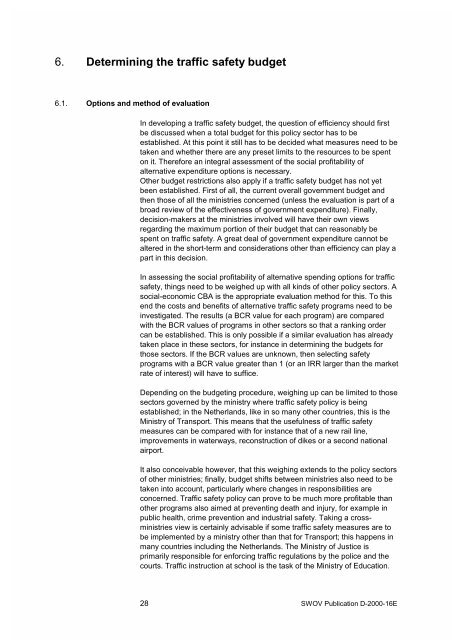Economic evaluation of road safety measures - Swov
Economic evaluation of road safety measures - Swov
Economic evaluation of road safety measures - Swov
Create successful ePaper yourself
Turn your PDF publications into a flip-book with our unique Google optimized e-Paper software.
6. Determining the traffic <strong>safety</strong> budget<br />
6.1. Options and method <strong>of</strong> <strong>evaluation</strong><br />
In developing a traffic <strong>safety</strong> budget, the question <strong>of</strong> efficiency should first<br />
be discussed when a total budget for this policy sector has to be<br />
established. At this point it still has to be decided what <strong>measures</strong> need to be<br />
taken and whether there are any preset limits to the resources to be spent<br />
on it. Therefore an integral assessment <strong>of</strong> the social pr<strong>of</strong>itability <strong>of</strong><br />
alternative expenditure options is necessary.<br />
Other budget restrictions also apply if a traffic <strong>safety</strong> budget has not yet<br />
been established. First <strong>of</strong> all, the current overall government budget and<br />
then those <strong>of</strong> all the ministries concerned (unless the <strong>evaluation</strong> is part <strong>of</strong> a<br />
b<strong>road</strong> review <strong>of</strong> the effectiveness <strong>of</strong> government expenditure). Finally,<br />
decision-makers at the ministries involved will have their own views<br />
regarding the maximum portion <strong>of</strong> their budget that can reasonably be<br />
spent on traffic <strong>safety</strong>. A great deal <strong>of</strong> government expenditure cannot be<br />
altered in the short-term and considerations other than efficiency can play a<br />
part in this decision.<br />
In assessing the social pr<strong>of</strong>itability <strong>of</strong> alternative spending options for traffic<br />
<strong>safety</strong>, things need to be weighed up with all kinds <strong>of</strong> other policy sectors. A<br />
social-economic CBA is the appropriate <strong>evaluation</strong> method for this. To this<br />
end the costs and benefits <strong>of</strong> alternative traffic <strong>safety</strong> programs need to be<br />
investigated. The results (a BCR value for each program) are compared<br />
with the BCR values <strong>of</strong> programs in other sectors so that a ranking order<br />
can be established. This is only possible if a similar <strong>evaluation</strong> has already<br />
taken place in these sectors, for instance in determining the budgets for<br />
those sectors. If the BCR values are unknown, then selecting <strong>safety</strong><br />
programs with a BCR value greater than 1 (or an IRR larger than the market<br />
rate <strong>of</strong> interest) will have to suffice.<br />
Depending on the budgeting procedure, weighing up can be limited to those<br />
sectors governed by the ministry where traffic <strong>safety</strong> policy is being<br />
established; in the Netherlands, like in so many other countries, this is the<br />
Ministry <strong>of</strong> Transport. This means that the usefulness <strong>of</strong> traffic <strong>safety</strong><br />
<strong>measures</strong> can be compared with for instance that <strong>of</strong> a new rail line,<br />
improvements in waterways, reconstruction <strong>of</strong> dikes or a second national<br />
airport.<br />
It also conceivable however, that this weighing extends to the policy sectors<br />
<strong>of</strong> other ministries; finally, budget shifts between ministries also need to be<br />
taken into account, particularly where changes in responsibilities are<br />
concerned. Traffic <strong>safety</strong> policy can prove to be much more pr<strong>of</strong>itable than<br />
other programs also aimed at preventing death and injury, for example in<br />
public health, crime prevention and industrial <strong>safety</strong>. Taking a crossministries<br />
view is certainly advisable if some traffic <strong>safety</strong> <strong>measures</strong> are to<br />
be implemented by a ministry other than that for Transport; this happens in<br />
many countries including the Netherlands. The Ministry <strong>of</strong> Justice is<br />
primarily responsible for enforcing traffic regulations by the police and the<br />
courts. Traffic instruction at school is the task <strong>of</strong> the Ministry <strong>of</strong> Education.<br />
28 SWOV Publication D-2000-16E
















